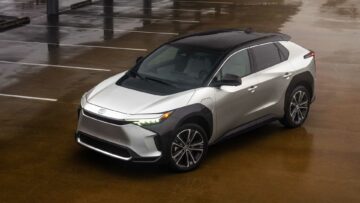More than three years have passed since BMW‘s designs have become more avant garde and controversial, a topic that has generated considerable discussion among fans and customers around the world. It began in June 2020 with the debut of the second generation 4 Series, fitted with a large new grille that generated far more negative feedback than positive.
This mid-size car arrived months after the unveiling of the BMW Concept 4 at the 2019 Frankfurt Motor Show. According to the company, the production 4 Series featured more than 80 percent of the concept’s design cues, including that massive kidney on the nose.
If we base our assumptions purely on the court of public opinion, it would seem this decision for the 4 Series would be a flop. But that’s not the case.
Positive Numbers
The issue can be better understood by analyzing car sales data around the world. Last year, BMW sold around 146,200 units of the current-generation model in all markets. Factoring in the coupe, convertible, four-door Gran Coupe, and electric i4, the 4 Series saw an 87 percent year-over-year increase versus 2021. In fact, it’s the company’s sixth best-selling product.
The criticism received has not stopped BMW designers from presenting even more polarizing models. In November 2020, the BMW iX SUV and its strange proportions were revealed. The large grille of the 4 Series may have shaken online forums, but BMW’s first all-electric SUV created digital chaos.
The iX had nothing to do with what the brand had presented up to that point. It was not just a question of the size of the grille, but of the entire vehicle, which notably was also the opposite of the conservative shapes of its rivals, namely the Audi E-Tron and the Mercedes-Benz EQC.
While criticism for the iX poured in, so did the money from buyers. The iX was the world’s best-selling large electric SUV in 2022, beating the E-Tron (now called the Q8 E-Tron) to rank among the world’s top-selling classic large SUVs.
7 Series Struggles
It’s not all good news in the BMW world, however. While the 4 Series and iX are relative newcomers in the BMW family, it’s conceivable buyers may not be as judgmental regarding polarizing designs. The seventh generation of the well-established 7 Series was introduced in April 2022, and given the conservative style of customers in this exclusive segment, a similar approach was expected.
Instead, BMW delivered a significantly different design many found as polarizing as the 4 Series. Aiming to stand out from the crowd and regain market share from the popular Mercedes-Benz S-Class, BMW gambled on a new look. Now, after one year on the market, it seems the gamble is not paying off. The 7 Series still lags behind the S-Class from a sales perspective in Europe, the US, and China.
As of September 2023, BMW sold just 3,700 units in Europe, compared to almost 10,300 sales for the S-Class. In the United States, The S-Class outsells the 7 Series nearly two to one. In China the, ratio is even larger: Over three Mercs for every Bimmer. The same goes for the i7 and EQS, too.
And Then There’s XM
The BMW XM arrived in September 2022, garnering gobs of criticism for its unusual design and massive size for a vehicle branded as a dedicated performance machine. However, after seven months on the market, BMW has sold 4,800 units globally. It’s the fifth best-selling M model in Europe and the United States. Moreover, the XM has surpassed the Lamborghini Urus for sales through the end of September. The bold SUV found 2,237 buyers versus 1,481 for the Italian super SUV.
The author of the article, Felipe Munoz, is an Automotive Industry Specialist at JATO Dynamics.
- SEO Powered Content & PR Distribution. Get Amplified Today.
- PlatoData.Network Vertical Generative Ai. Empower Yourself. Access Here.
- PlatoAiStream. Web3 Intelligence. Knowledge Amplified. Access Here.
- PlatoESG. Carbon, CleanTech, Energy, Environment, Solar, Waste Management. Access Here.
- PlatoHealth. Biotech and Clinical Trials Intelligence. Access Here.
- Source: https://www.motor1.com/news/695573/bmw-controversial-design-language-motor1-numbers/
- :has
- :is
- :not
- $UP
- 1
- 10
- 16
- 200
- 2019
- 2020
- 2021
- 2022
- 2023
- 237
- 300
- 7
- 700
- 80
- 87
- 9
- a
- According
- After
- Aiming
- All
- all-electric
- almost
- also
- among
- an
- analyzing
- and
- approach
- April
- ARE
- around
- arrived
- article
- AS
- assumptions
- At
- author
- automotive
- automotive industry
- Avant
- base
- BE
- become
- began
- behind
- Better
- BMW
- bold
- brand
- branded
- but
- buyers
- by
- called
- CAN
- car
- case
- Chaos
- China
- classic
- COM
- company
- compared
- concept
- conservative
- considerable
- content
- controversial
- Court
- created
- criticism
- crowd
- Customers
- data
- decision
- dedicated
- delivered
- Design
- designers
- designs
- DID
- different
- digital
- discussion
- do
- Electric
- end
- Entire
- Europe
- Even
- Every
- Exclusive
- expected
- fact
- factoring
- false
- family
- fans
- far
- featured
- feedback
- fifth
- First
- For
- forums
- found
- from
- Gamble
- garnering
- generated
- generation
- given
- Globally
- Goes
- good
- had
- Have
- helping
- However
- HTTPS
- image
- in
- Including
- Increase
- industry
- introduced
- issue
- IT
- Italian
- ITS
- jpg
- june
- just
- kidney
- language
- large
- larger
- Last
- Last Year
- Look
- machine
- many
- Market
- market share
- Markets
- massive
- max-width
- May..
- mid-size
- model
- models
- money
- months
- more
- Moreover
- Motor
- namely
- nearly
- negative
- New
- newcomers
- news
- nose
- notably
- nothing
- November
- now
- numbers
- of
- off
- on
- ONE
- online
- Opinion
- opposite
- or
- our
- out
- over
- passed
- paying
- percent
- performance
- perspective
- plato
- Plato Data Intelligence
- PlatoData
- Point
- Popular
- positive
- presented
- Product
- public
- public opinion
- purely
- question
- rank
- ratio
- received
- regain
- regarding
- relative
- Revealed
- rivals
- s
- sales
- same
- saw
- Second
- Second Generation
- seem
- seems
- segment
- September
- Series
- seven
- shapes
- Share
- significantly
- similar
- sixth
- Size
- So
- sold
- specialist
- stand
- States
- Still
- stopped
- strange
- style
- Super
- surpassed
- SUVs
- than
- that
- The
- the world
- then
- There.
- this
- three
- Through
- to
- too
- topic
- true
- two
- understood
- United
- United States
- units
- unusual
- unveiling
- us
- vehicle
- Versus
- was
- we
- webp
- were
- What
- which
- while
- with
- world
- would
- XM
- year
- years
- zephyrnet













